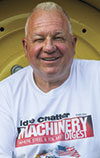Situation No. 1 There is a good deal of coffee shop talk about higher ethanol blends in gasoline.
You know many vehicles say “flex fuel” on them over the past number of years and can use higher-ethanol-content gasoline. However, you do not truly understand what that means beyond the obvious.
Since you sell some of your corn to an ethanol plant, you feel it is time to learn about flex-fuel engines. You ask some of your friends, and they each have an opinion. Which farmer is the most correct?
A. Farmer A says that with a flex-fuel system, you can use gasoline with ethanol content up to E-85. He says that it is accomplished by using special head gaskets in the engine.
B. Farmer B agrees with Farmer A regarding E-85 but says it is not the head gaskets but unique fuel lines and a sensor to determine the ethanol content in the gas.
C. Farmer C agrees with Farmer B but says there is more to it than fuel lines and a sensor. The engine control computer needs to alter the injector pulse width (opening) and the ignition timing to accommodate higher proportions of ethanol.
D. Farmer D says he doesn’t give a hoot. In the late 1970s, he put gasohol in his Volkswagen Bug and burned up the engine.
Situation No. 2
You are buying a new Ford F-150, but you do not know what engine to get. A base V-6, a V-8 and two turbocharged options – a 2.7-liter and a 3.5-liter. You decide on the base V-6 without any turbocharger.
At the winter growers’ meeting, you tell some friends over lunch about the truck you ordered. Then you ask them how a turbocharger on a gas or diesel engine creates more power. They respond by saying:
A. Farmer A says that the turbocharger helps get the exhaust out since it acts as a fan. This is the reason for the power increase.
B. Farmer B disagrees with Farmer A. He states that the turbocharger helps spin the crankshaft, and that is why there is an oil line to it and often engine coolant.
C. Farmer C says a turbocharger increases the engine’s volumetric efficiency and raises the pressure on the top of the piston when it is at bottom dead center.
D. Farmer D believes turbocharging works differently on a gasoline engine than a diesel. With a diesel, it raises the static compression ratio.
Answers
Situation No. 1: Farmer C is correct. A flex-fuel engine needs to compensate for the lower energy density and different flame speed with ethanol. Depending on the application of the same engine in non-flex fuel form, it may have different fuel lines, larger injectors, a means to determine the ethanol content of the fuel, but most important, a unique calibration in the engine controller. In addition, the fuel delivery and ignition tables are altered.
Situation No. 2: Farmer C is correct. A turbocharger feeds more air into the cylinder to trick the engine into thinking it has a larger displacement. The amount of cylinder fill is identified as volumetric efficiency. When the piston is at BDC (bottom dead center), the spinning compressor wheel of the turbocharger also raises the pressure above atmospheric on the piston. This is a secondary effect since the power gains come from volumetric efficiency.
Email “The Hotrod Farmer” Ray Bohacz with your machinery-related questions. Visit his site – Farm Machinery Digest – for technical articles and to listen to his Idle Chatter podcast, which has listeners in 67 countries. Also tune into Farm Machinery Digest Radio on Sirius/XM Channel 147.










